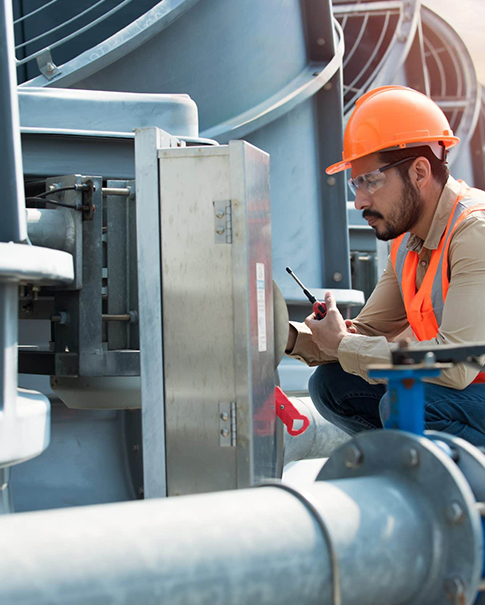Application Of Mold Temperature Controller In Cast Film Calendering Process
Feb 24, 2025
As a leading enterprise in the field of industrial temperature control, Hengde Company has focused on the research and development, production and sales of mold temperature controllers for many years. With its advanced technology, exquisite craftsmanship and strict quality control, Hengde mold temperature controller has been widely used in many industrial fields such as cast film calendering with precise temperature control, efficient performance and reliable stability, providing a strong guarantee for enterprises to improve product quality and production efficiency.
In the cast film calendering process, the mold temperature controller (commonly called temperature control unit or TCU) plays a vital role in maintaining the precise and constant temperature of the rollers (calender) and other components involved in the process. Cast film calendering mold temperature controller, also known as cast film calendering oil heater or cast film calendering electric heating oil furnace, is a special mold temperature controller for cast film plastic thermoforming. Cast film calendering mold temperature controller is designed for PET cast film, PVC cast film, PP cast film, EVA cast film, multi-layer co-extrusion cast film production line, roller temperature control. It controls the temperature of the mold or roller to ensure that the cast film has a stable temperature environment during the thermoforming process, thereby improving product quality and production efficiency. Proper temperature control is essential to ensure the quality, thickness and surface finish of the cast film.
Role of Mold Temperature Controller in Cast Film Calendering:
1. Temperature Regulation:
The mold temperature controller ensures that the calender rollers are maintained at the desired temperature, which is crucial for achieving uniform film thickness and surface properties.It prevents overheating or undercooling, which can lead to defects such as uneven surfaces, poor adhesion, or inconsistent film properties.
2. Material Flow and Cooling:
The molten polymer is extruded onto the calender rollers, where it is shaped and cooled. The temperature controller ensures that the rollers are at the optimal temperature to facilitate proper material flow and cooling rates.Controlled cooling prevents warping, shrinkage, or other dimensional instabilities in the final film product.
3. Surface Finish:
The temperature of the rollers directly affects the surface finish of the film. A well-controlled temperature ensures a smooth, glossy, or matte finish, depending on the desired product specifications.
Key Features of a Mold Temperature Controller in Calendering:
Precision Control: Ability to maintain temperatures within a tight tolerance range (±1°C or better).
Heating and Cooling Capabilities: Equipped with both heating and cooling systems to adjust temperatures as needed.
Flow Rate Control: Ensures proper circulation of the heat transfer fluid (e.g., water, oil) through the rollers.
User Interface: Digital controls and displays for easy monitoring and adjustment of temperature settings.
Safety Features: Overheating protection, alarms, and emergency shutdown systems.
Temperature range: room temperature to 300°C, meeting the different temperature requirements in the production process of cast film.
Temperature control accuracy: pid±1℃, ensuring the accuracy and stability of temperature control.
Output selection: contactor/solid-state relay/thyristor, select the appropriate output mode according to production needs.
Power selection: 6-360KW (power can be customized) to meet the needs of production lines of different scales.
Applications in Cast Film Calendering:
Polymer Films: Used in the production of PVC, PET, PP, PE, and other polymer films.
Packaging Materials: For food packaging, industrial films, and laminates.
Decorative Films: For surfaces, wallpapers, and automotive interiors.
When a plastic film manufacturer was producing cast polypropylene (CPP) film, the original temperature control equipment was not accurate enough, resulting in uneven film thickness, surface streaks and other quality problems, and a high defective rate. After the company introduced the Hengde mold temperature controller, the mold temperature controller accurately controlled the temperature of the extruder, die head and calender roller. The temperature fluctuation of the extruder barrel was controlled within ±1℃, the temperature deviation of each area of the die head did not exceed ±0.5℃, and the surface temperature uniformity of the calender roller was significantly improved. After a period of production practice, the thickness deviation of the film was reduced from the original ±5% to within ±2%, the surface quality was significantly improved, the defective rate was reduced from 10% to less than 3%, and the market competitiveness of the product was greatly improved.
In summary, the mold temperature controller is a vital component in the cast film calendering process, ensuring precise temperature management for optimal film production. Proper selection and operation of the temperature control system are key to achieving high-quality film products.
Choose Hengde,Choose Perfect Mold Temperature Controller!
